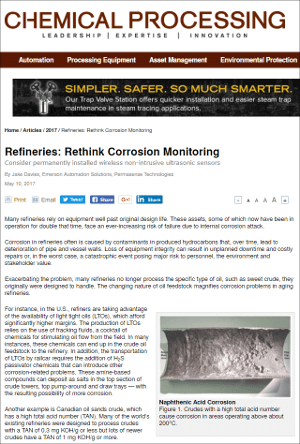With the diversification of crude oil types brought about by U.S. shale production, refineries have increased risk for vessel and piping corrosion. Many of the aging refineries also are operating past the design life of some of their plant assets.
In a Chemical Processing article, Refineries: Rethink Corrosion Monitoring, Emerson’s Jake Davies describes some of these challenges and ways that wireless corrosion monitoring can help to address them.…lead to deterioration of pipe and vessel walls. Loss of equipment integrity can result in unplanned downtime and costly repairs or, in the worst case, a catastrophic event posing major risk to personnel, the environment and stakeholder value.
Shale oils, crude oils shipped by rail and oil sands crude all may contain various added chemicals from their respective production processes. For example, rail car transported crude may contain:
…H2S passivator chemicals that can introduce other corrosion-related problems. These amine-based compounds can deposit as salts in the top section of crude towers, top pump-around and draw trays — with the resulting possibility of more corrosion.
Jake notes that many of these non-traditional crude oil sources also have a higher total acid number (TAN) which also drives increased corrosion. Two methods for addressing these corrosive effects include:
…upgrading the metallurgy of many or all the susceptible areas, often to expensive high-nickel alloys or titanium; or using chemical corrosion inhibition treatment.
Jake explains that either approach should:
…include online corrosion monitoring at critical locations to verify the state of the metallurgy upgrade or the inhibitor distribution and effectiveness. Alternatively, online corrosion monitoring can validate that the existing mitigation strategy is performing adequately.
He shares some of units most at risk including sour-water strippers, crude and amine units and terminal jetties to name a few.
Traditional corrosion monitoring has been performed with the use of probes. Corrosion on the tip of the immersed probe can approximate the corrosion on the vessel or pipe wall. He notes two disadvantages of probes:
- The center-line measured corrosion at the tip may not match the corrosion rate at the pipe wall.
- The tip often corrodes away after two to three years while many refineries now operate five or more years between major turnarounds.
Ultrasonic technology can be used to measure wall thickness. This testing has traditionally been performed manually at intervals of many months to years.
Externally mounted, wireless ultrasonic sensors are now available to measure wall thickness. These sensors enable plant personnel:
…to make the right decisions at the right time about when and where to carry out critical maintenance to support safer and more-economic operations.
Read the article for more on examples of use in sour-water strippers and the results achieved.
You can connect and interact with other wireless instrumentation experts in the Wireless group in the Emerson Exchange 365 community.






